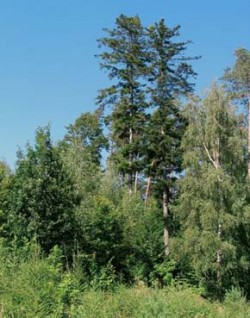Po skončení poslední doby ledové, kdy bylo mnoho druhů středoevropské flóry zatlačeno do jižní Evropy, se začala jedle bělokorá (Abies alba) do střední Evropy vracet. Maximálního rozšíření dosáhla zhruba před 2 000 až 1 000 let, kdy pronikla nejen do horských poloh, ale i do pahorkatin. Pokles zastoupení jedle v našich lesích nastal již v 18. stol., nejvýraznější ale byl v průběhu 20. stol. Jeho příčinou byla pravděpodobně kombinace klimatických změn, znečištění půdy a ovzduší a nízká genetická variabilita.
After the end of the glacial period, during which many species of Central-European flora shifted to Southern Europe, silver fir (Abies alba) began to return to Central Europe. The species was most widely distributed about 2000-1000 years ago, when it penetrated not only to mountain altitudes but also to hilly areas. Decline of the fir share in the species composition of forests began as early as in the 18th century, but reached its peak in the 20th century. This was probably caused by a combination of climate change, soil contamination, air pollution and the low genetic variability of fir.
 Jedle bělokorá (Abies alba) ve smíšeném porostu na okraji vojenského újezdu Březina u Vyškova. Jde zřejmě o pozůstatek původních bučin, ve kterých jedle tvořily příměs; dnes má převahu smrk. Foto J. Buřival / © J. Buřival
Jedle bělokorá (Abies alba) ve smíšeném porostu na okraji vojenského újezdu Březina u Vyškova. Jde zřejmě o pozůstatek původních bučin, ve kterých jedle tvořily příměs; dnes má převahu smrk. Foto J. Buřival / © J. Buřival



